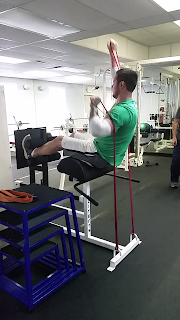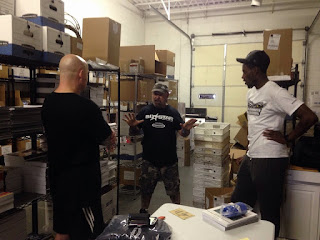One of the most talked about topics I see in the fitness blog-o-sphere and social media is programming. I always see comments asking “what program you’re doing”, or “I’m starting this program Monday”. I used to read a popular online muscle zine’ and every time an author would post a training article the comments would read “Starting this tomorrow!”, “just what I needed!” and so on.
I’m here to tell you that the absolute best program you can do is no program. Unfortunately this truth won’t sit well with fitness journalists and gurus who need to publish the latest, greatest training program each month. Plus endless articles about training principles would be incredibly boring for the average gym rat. However, that is where the results are at, in the principles.
 |
| EPTS athlete and BJJ brown belt Chris Jones uses exercises HE needs for his sport. |
It’s about principles not programs.
The problem with programs is that one size does not fit all. Programs don’t take into account an individual’s weak points. No one should train exactly the same. That doesn’t mean a group of powerlifters shouldn’t squat or bench press, but how they go about building those movements may differ greatly. If someone’s hamstrings are a weak point in the deadlift, they will prioritize different accessory exercises than someone who’s lower back is a weak point.
Before I continue I do believe programs are good for beginners. If you are just starting out and have less than 1-2 years of consistent training under your belt, a well balanced program is a good idea. Something that trains all muscle groups in a balanced manner with a wide variety of exercises. This isn’t time for the super secret Russian squat, bench, deadlift only for hard comrades training program. If you are a beginner you need to build muscle and strength. A program introducing compound exercises with appropriately selected single joint exercises that increases in volume and intensity over time will deliver great results. Eventually some movements and muscle groups will start to slow in progress and it’s at this point you will need to learn to take responsibility for your training and learn the principles of training.
 |
| Using accomodating resistance for speed deadlifts to build rate of force production and lockout strength. |
The principles.
According to Vladimir Zatsiorsky, in his book “Science and Practice of Strength Training”, there are three methods of training to increase muscular tension.
Maximal Effort Method - lifting a maximal weight.
Dynamic Effort Method - lifting a non-maximal load with the greatest possible force.
Repeated Effort Method - lifting a non-maximal load to failure.
*There is also a method he refers to as the sub-maximal effort method, which is the lifting of a non-maximal load for an intermediate number of repetitions without going to failure.
These training methods also make up a significant part of the work my mentor Louie Simmons has successfully done with athletes as well as his world famous powerlifting team. Louie takes these methods, and scientifically backed training principles, and applies them to powerlifting, as well as other sports like fighting, track, football and many others. On a recent visit to Westside Barbell I was having breakfast with Louie and his crew and he confirmed a suspicion I had as to why most people don’t understand his conjugate training method. People are always looking for a program, a cookie cutter template they can take to the gym and do without any thought. That’s not what his method teaches. His method teaches you the scientific principles of training but you need to learn how to apply them to your sport. He said to me that it is important to learn how to train yourself by constantly assessing your progress and implementing the appropriate exercises to build your weak points and that no two athletes or lifters programs are identical.
 |
| Learning from Louie himself. If you want to understand the Westside method, you have to go to Westside. |
In order to get stronger you must raise your training volume and intensity over time. In short you need to lift heavier weights and do more work while addressing all training principles and variables appropriately. Sure, some people like to say getting strong isn’t rocket science, you just add more weight to the bar, but I have yet to see a high level athlete who doesn’t pay attention to every detail of his physical training program.
Does this apply to the strength enthusiast? Absolutely. Whether you are training to be a world champion or just to get stronger and more generally fit you need to apply the appropriate principles to your training.
 |
| Just some of the equipment our athletes and clients have access to at Extreme Performance Training Systems. |
Don’t fall into the trap of doing the latest program your favorite muscle rag or blogger has posted, take the time to evaluate your training and learn how to build and evolve a training plan that will allow you to accomplish your personal goals.
Stay Strong and Healthy!
-Scott



